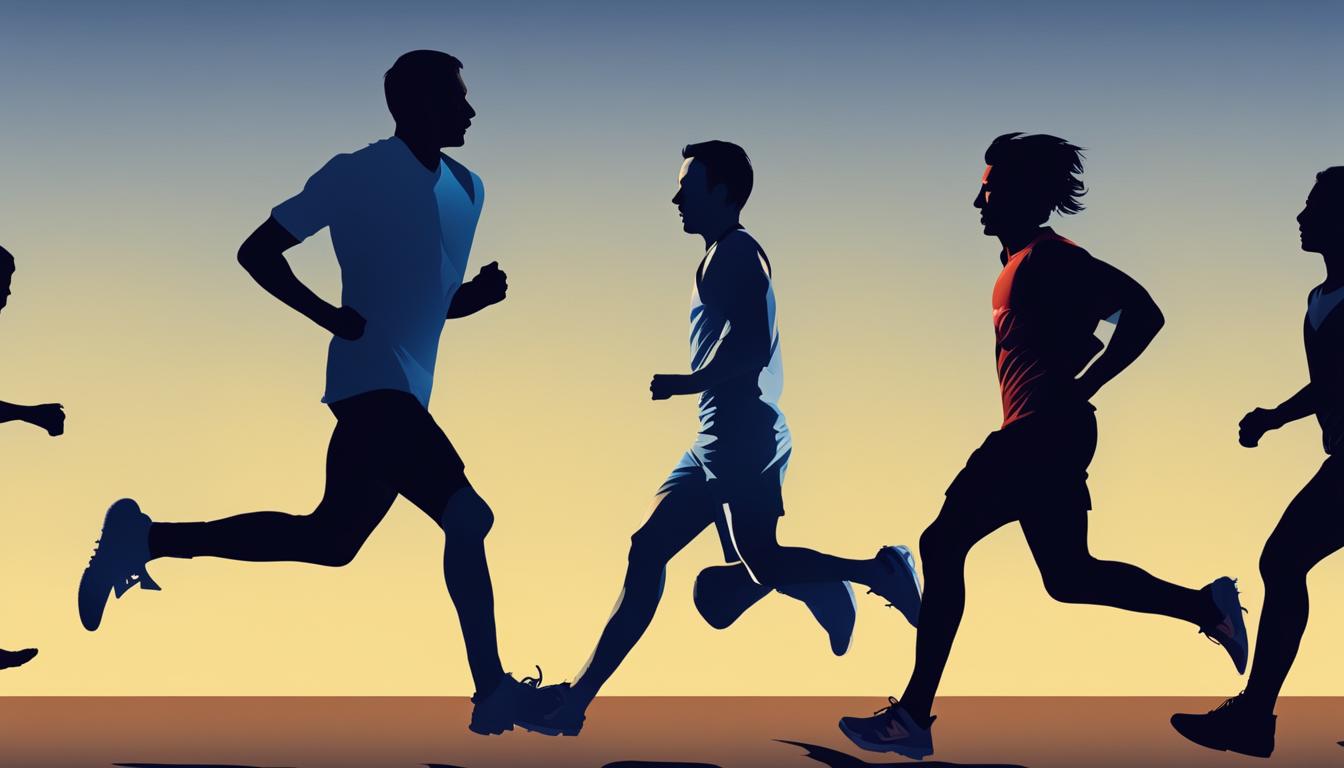The origins and historical development of running are as ancient as humanity itself, tracing the activity back to a time when the evolution of running coincided with the very survival of our ancestors. Embedded within our species’ DNA, running commenced not as a deliberate invention but as an organic progression essential for evasion and pursuit. Delving into the depths of prehistory to answer “when did humans start running?” reveals that the running invention timeline aligns with evolutionary milestones rather than a single moment of creation.
Unraveling the mystery around “the invention of running“, one must explore the early adaptability of humans who, over eons, transitioned from quadrupedal locomotion to bipedalism. This transformative journey ignited the capability to run, driving an archaeological quest that sifts through geological epochs to map out this fundamental human feature.
Key Takeaways
- The concept of an “invention” of running is a misnomer; running evolved as a human trait out of necessity.
- Investigating the historical development of running spans across multiple disciplines, including anthropology and paleontology.
- The evolution of running has been pivotal in human history, affecting cultural, social, and survival aspects.
- Significant moments in running history provide insights into human endurance and innovation.
- Running has grown to transcend its primal purpose, becoming a globally celebrated athletic and recreational activity.
Unraveling the Ancient Origins of Running
The origin of running is as ancient as the human species itself. Anthropological discoveries have provided evidence suggesting that running in prehistoric times was integral to the very survival of early humans. As hunter-gatherers, our ancestors required a set of physical skills that included the capacity for endurance and speed. Records such as the Sahelanthropus tchadensis fossils indicate that the early development of running may have been a consequence of evolutionary adaptions which enabled hominids to travel more efficiently on two feet.
In the context of running during early civilizations, this primal activity assumed a new role. While initially, it was primarily a means of securing sustenance and evading predators, running began to acquire social and cultural dimensions within ancient communities. The earliest evidence of running as a structured practice comes from various archeological findings that point to running being incorporated in ceremonial and competitive arenas.
When considering the ancient origins of running, it is noteworthy to recognize how these practices laid the groundwork for the athletic disciplines that followed. Below is an overview of how running was manifest in various civilizations, evolving from a survival technique to an organized sport:
| Civilization | Significance of Running | Notable Evidence |
|---|---|---|
| Egyptian | Royal couriers and military training | Pictographs and inscriptions depicting messengers and soldiers running |
| Greek | Competitive sports, especially the Olympics | Historical records of Olympic Games featuring running events |
| Mesoamerican | Religious and communal rituals | Ancient ball games and ceremonies with running elements |
| Celtic (Ireland) | Tailteann games with races to honor the dead and celebrate victory | Mythological accounts and later historical documents referencing running contests |
The tapestry of our history, rich with the exploits of runners traversing distances for communication, survival, and competition, underscores the fundamental nature of this activity. Today, we continue to uncover more facts about the ancient origins of running, threading together the pieces of our past with the continuity of an action that is inherently human.
Tracing the Timeline of Running Through History
The tapestry of running history stretches back across the ages, firmly entwined with the growth of civilizations and the unfolding of human evolution. The chronicle of how running in human history transformed from a primal activity to a structured sport offers insights into the origins and development of this athletic pursuit.
The Dawn of Endurance Running
By piecing together a running history timeline, one can find that the origins of endurance running lie in the necessary survival tactics of our ancestors. Believed to be invented around 7 million years ago, the skill of running emerged shortly after bipedal walking. Ancient humans capitalized on endurance running to sustain themselves through persistence hunting, a testament to their early history of running. With long limbs and an impressive cooling system, they distinguished themselves within the natural realm, showcasing their evolved capacity for long-distance travel.
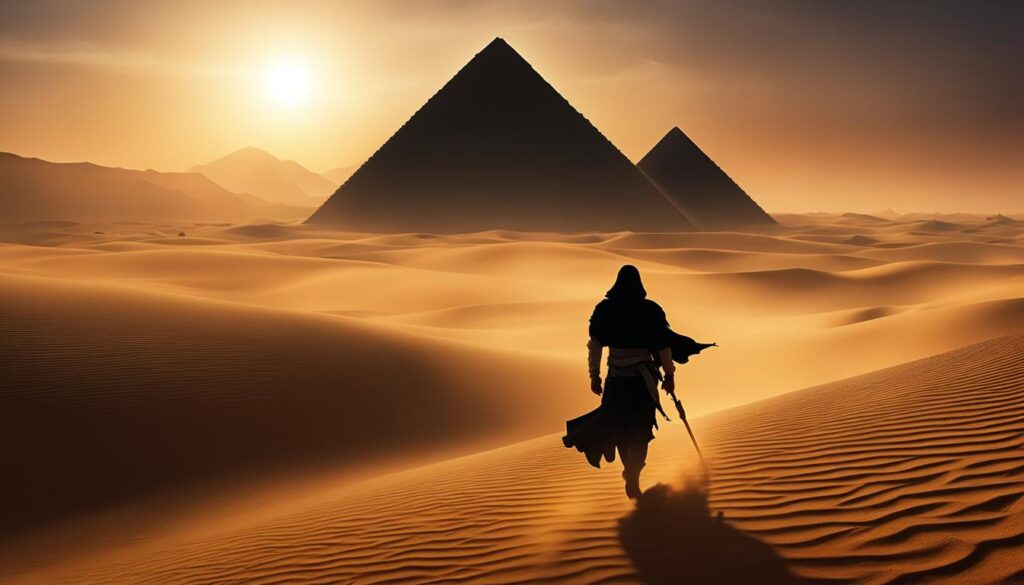
Running’s Role in Ancient Civilizations
As stable societies began to emerge, the utility of running expanded within ancient civilizations. It transitioned into a critical skill for couriers and a central element in military training. The role of early runners like Pheidippides, famed for his marathon from Marathon to Athens, illustrates the significance of the history of running in cultural contexts. King Taharka of Egypt later institutionalized endurance running within his military, underscoring running in ancient civilizations as both a profession and a regimen for warriors.
While the earliest instances of running in recorded history highlight its developmental milestones, they also reflect the gradual development of running as a sport. From a means to survive to a necessary skill in burgeoning societies, the story of running is rich with feats of endurance, pivotal roles in communication, and essential military practices.
The Evolution of Running From Survival to Sport
The evolution of running mirrors the broad narrative of human progress. Once an instrumental survival skill and a means of communication across vast terrains, running gradually morphed into a globally celebrated sport, deeply ingrained in human culture. This transformation was neither swift nor straightforward; it spanned across millennia, leaving a significant mark on the history of civilization. Today’s athletes now stand upon the shoulders of our ancestors, whose strides have long outrun the sands of time.
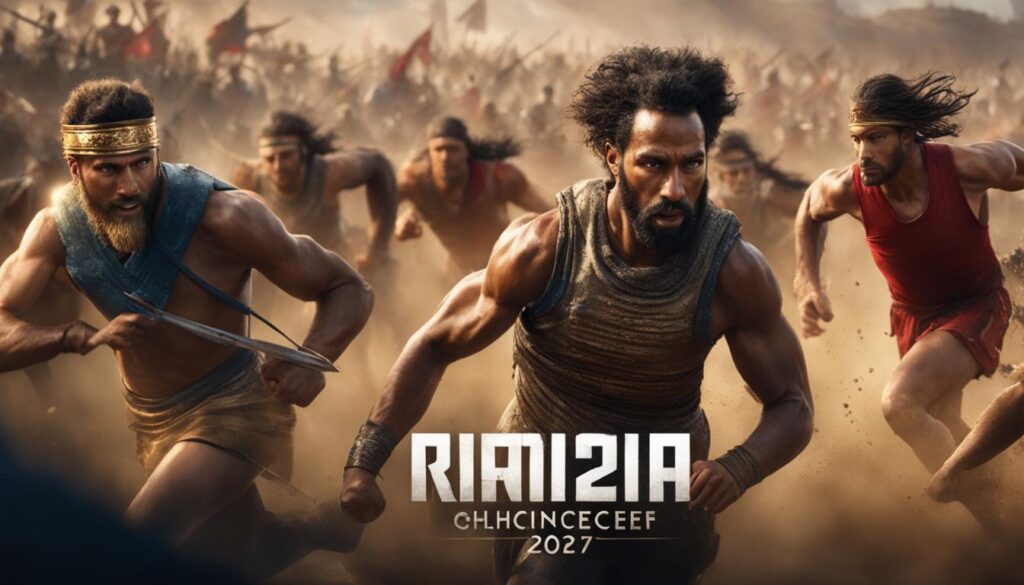
From its ancient development, the running evolution has been closely tied with humanity’s quest for faster, longer, and more challenging forms of competition. Initially, the act of running addressed pressing physiological needs and later, it encapsulated virtues such as valor and determination, as seen in the ancient Olympic traditions. With each passing era, the development of running unfolded through a fascinating interplay of cultural practices, technological advancements, and shifts in social consciousness.
The emergence of running as a sport can be seen as an extension of these primal roots. Both the structure and the spirit of formal running competitions can be traced back to ancient Greece, where prestigious events in the early Olympics forged running into a pursuit of excellence and honor.
“Running is rooted in our very essence, yet it has transcended its primal past to become a testament to the power and tenacity of the human spirit; its competitive form is a celebration of our collective endurance.”
To examine the historic progression of running, consider the contrast between survival running and competitive running, each with its own implications, techniques, and philosophies. This remarkable journey from utility to sport elucidates the profound running evolution that we witness today.
| Timeline | Running for Survival | Running as a Sport |
|---|---|---|
| Ancient Times | Persistence hunting techniques | Religious and ceremonial foot races |
| Classical Antiquity | Messenger systems in civilizations | Organized competitions, the early Olympics |
| Medieval to Early Modern Era | Decline due to advancements in transportation | Races for entertainment and military training |
| 19th Century to Present | Sportification of various types of running (sprints to marathons) | Standardized rules, international sporting events |
Traversing through the annals of history, we witness the ancient development of running bloom into a rich, multifaceted mosaic of human enterprise. Running throughout history therefore not only maps a physical journey but also charts a course through the social, cultural, and technological tides that have shaped our world.
Early Evidence of Running in Prehistoric Times
The early history of running is bound to the very fabric of our evolution. Investigating the early evidence of running brings us to pivotal moments in the ancient prehistoric landscape—where the earliest record of running and the archaeological evidence of running reside. The running origin date remains elusive, but our understanding of the early development of running remains deeply rooted in our ancestors’ shift toward bipedalism and perseverance in the demanding environments they inhabited.
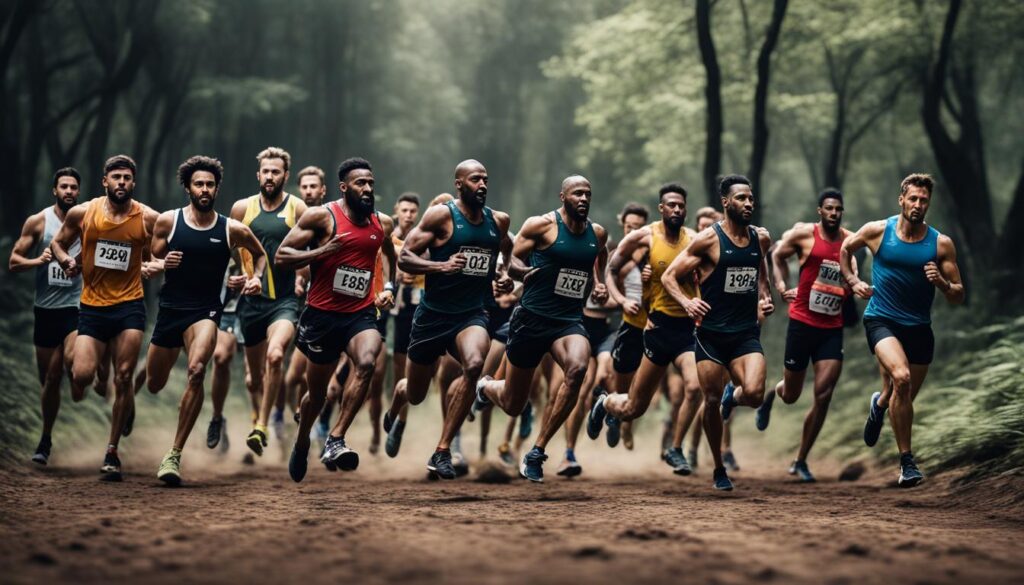
This section examines the ancient running techniques and the early running techniques, considering how the endurance and adaptation of our ancestors laid the groundwork for the sophisticated practice known today. The running discovery oscillates not just as a mere activity, but as a consequential milestone in human history, intricately linked to our species’ survival and social development.
Discovery of Bipedal Locomotion in Hominids
Among the most significant revelations about running’s origins is the transition to upright walking in early hominids. The controversial yet groundbreaking fossils of Sahelanthropus tchadensis hint at an era when our predecessors were starting to find balance on two feet, a preliminary step towards the eventual adoption of running as a natural movement. It showcases an origin of endurance running that is as much about physical evolution as it is about the transformation of landscapes and ecosystems humans found themselves within.
Persistence Hunting and Ancestral Running Techniques
A key example of ancient running techniques can be seen in the concept of persistence hunting—a strategy used by our ancestors for whom speed was less crucial than the ability to endure. Endurance running, in this context, trumped the simple act of outrunning a rival or prey for short distances. Evidence from archaeological findings suggests that around 2 million years ago, adaptations like the Achilles tendon allowed for efficient locomotion across extended distances—a feature that has stood the test of time in the anatomy of modern humans.
| Feature | Advantage | Impact on Running |
|---|---|---|
| Achilles tendon | Elastic energy storage | Facilitates endurance running |
| Elongated legs | Longer stride | Greater distance covered per cycle |
| Arched foot | Shock absorption | Reduces injury and improves efficiency |
| Nuchal ligament | Stabilizes the head | Allows for steady vision while in motion |
| Perspiration system | Cooling during prolonged exertion | Extends potential for persistence hunting |
Our understanding of these ancestors not only contributes to our comprehension of the early development of running but also touches upon the social constructs that likely developed in parallel. Today’s running may be more recreation than requirement, but the essence of this primal pursuit lives on in every step taken by the modern runner.
Historic Races and Running in Classic Antiquity
Reflecting on the epoch of running in ancient times, one can’t help but marvel at the exceptional events that highlight the history of running. These historic races not only demonstrated physical mastery but also woven into the societal fabric, underline the importance of running in human narrative and culture.
The Ancient Tailteann Games in Ireland
Long before the hype of modern-day marathons, the earliest mention of running can be traced to the vibrant cultural tapestry of the Tailteann Games. These games bore testimony to running through the ages as a festive and competitive engagement. Rich with ceremonial splendor, ranging from funerary honors to the establishment of new laws, the games included contests of speed and endurance. It was here that some of the first runners became legends, their feats etched in the annals of the history of running.
Myth and Reality: Pheidippides, the Legendary Messenger
In the chronicles of running messengers, none have captivated the imagination quite like Pheidippides. Whether myth or historical figure, his legendary sprint from Marathon to Athens left an indelible mark on the earliest records of running. This narrative of a runner’s grit and determination highlights the instrumental role of running in ancient civilizations, and how the profession of running messengers was crucial in times when fast communication was a necessity.
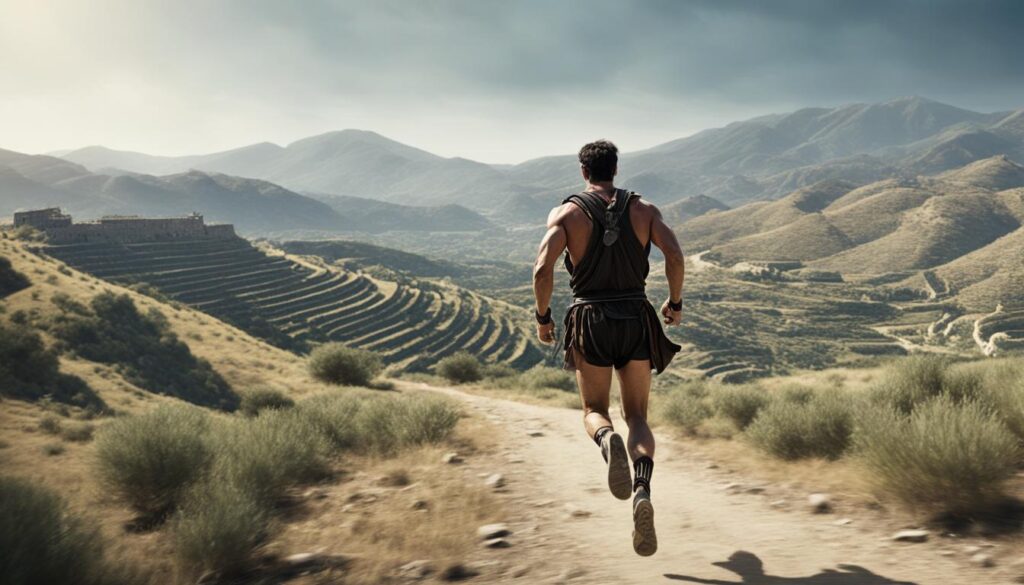
The commemoration of Pheidippides through the Olympic marathon distance underlines the deep respect for his storied journey, and exemplifies how the feats of early runners are immortalized, as we continue to reverently measure the history of running. His tale, whether born from history or fable, speaks to the enduring human spirit, truly encapsulating the essence of running in human history and the eternal allure of long-distance endeavors.
Cultural Significance of Running in Ancient Societies
The act of running, pervasive in the tapestry of human activity, has long epitomized the fusion of physical prowess with symbolic importance. Throughout history, as we peer back into the annals of time, running in ancient times was not merely a show of athleticism but a crucial marker of cultural identity. Ancient civilizations ingrained running into their core societal structures as they recognized its multitude of purposes beyond mere transportation of body from one point to another. This reverence for the act is reflected in the extensive cultural running history, where it served as the backbone of many a festival, ceremonial rite, and legal enactment.
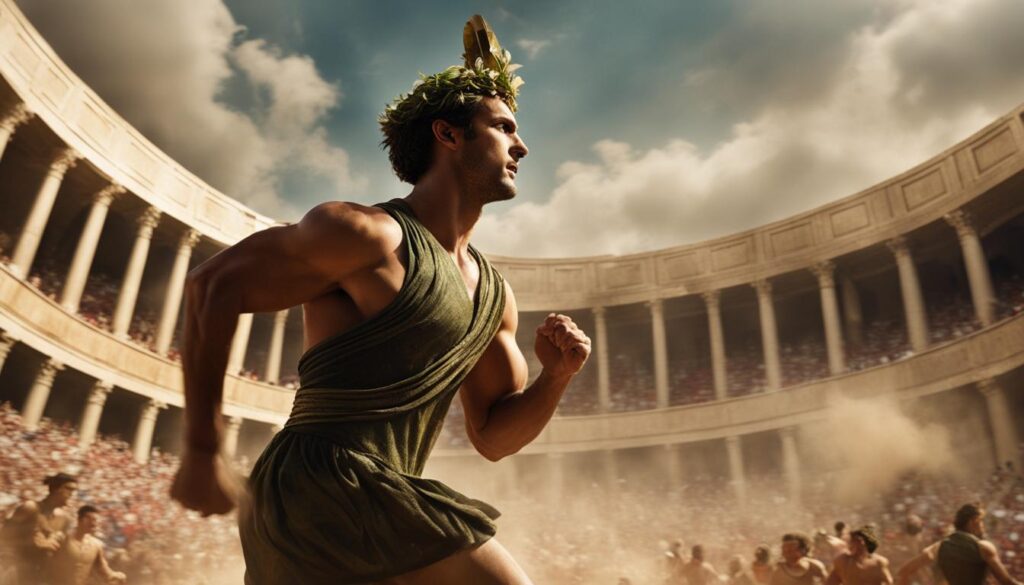
Particularly in Greece, Rome, and Egypt—cultures renowned for their contributions to the development of running in human history—races were moments when society paused to witness the manifestation of human potential. Through various accounts and remnants, it is evident that running transcended the physical realm and ventured into the metaphysical, often assuming the role of a liaison between mortal achievements and divine aspirations.
In the words of the ancients, “To run is to commune with the gods, to share in the earth’s rhythm, and to re-enact the chronicles of heroes.”
Might we venture to categorize this significant element of historical lore, the task would bring forth a tableau illustrating running through the centuries, reminiscent of the growth of civilizations themselves. Here is a glimpse into how running permeated various aspects of ancient life:
| Civilization | Running Events | Cultural Role |
|---|---|---|
| Greek | Olympiad Races | Celebration of athletic heroism and divine favor |
| Roman | Circus Maximus Chariot Races | Manifestation of power and entertainment |
| Egyptian | Pharaoh’s Coronation Run | Assertion of divine right to rule |
In each of these societies, running embodied more than competition; it signified harmony with the universe and each footfall echoed the pulse of a civilization. Unarguably, the running history is as complex as it is profound, spanning across muddied battlefields to hallowed rituals in its significance. Thus, we conclude that the ancient civilizations and running were interconnected, with each stride across dusty Athenian plains or along the Nile symbolizing a story etched into the annals of time, echoing a narrative that whispers of endurance, triumph, and the unyielding human spirit.
Olympic Glory: Competitive Running’s Emergence in 776 BC
The foundation of the Olympic Games in 776 BC marked a transformative era in the running history timeline, solidifying the cultural and athletic legacy of competitive running events. At the heart of Olympia, stood a pantheon of disciplines, eagerly showcasing the finesse and spirit of Greek athletes, charting a course for running through history. These games transcended mere sport; they were a profound religious and social gathering, carving an eternal niche for running in the Olympics.
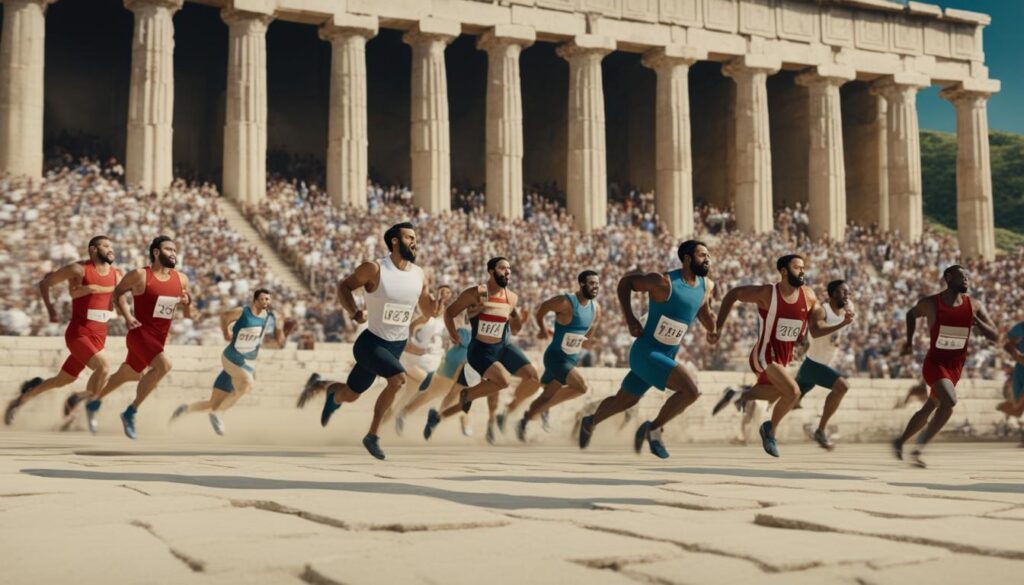
Championing athleticism and valor, the ancient Olympics shed light on the history of running by welcoming not just warriors but also any free men of Greece to partake. This drew parallels with the age-old Tailteann Games, yet distinguished itself by spawning a more universal celebration of physical excellence. A plethora of running events unveiled the breadth of talent and endurance, fueling a sporting fervor that has reverberated through millennia.
In detailing the pageantry of these early competitions, one can vividly reimagine the echoing cheers of thousands, crafting a vibrant tapestry of history that honors the legacy of these ancient champions. From the sprinting Stade race to the arduous Dolichos, each contest added a thread to the rich fabric of the history of running. Not only capturing the imagination but also the communal aspirations of an evolving society, the original Olympic Games paved the way for running in the Olympics — an enduring tradition that continues to inspire and challenge the finest athletes in the world today.
- The pivot from military to inclusive competition demarcated a new chapter in the history of running.
- Emphasizing both individual glory and collective achievement, running unified the Hellenic states in reverence of exceptional prowess.
- The longstanding traditions of these games still resonate, influencing modern-day athletic ceremonies and the spirit of the global Olympic movement.
Indeed, the echoes from Olympia’s grand stadium continue to fuel the passion for competitive running events, enshrining the Olympic Games as a timeless beacon of excellence in sports and human fortitude throughout history.
When Was Running Invented: Decoding the Myth
The quest to pinpoint when was running invented often leads to the misleading notion that this fundamental human activity was one day deliberately conceptualized. However, the running history timeline aligns more closely with evolutionary milestones rather than the flick of an inventor’s pen. The invention of running is not an invention per se but an innate capacity tightly interwoven with running’s origins.
The seminal moment in the running discovery corresponds to the dawn of bipedalism. Our early ancestors forged a path that would eventually distinguish them as foremost endurance runners on the planet. There is no singular running invention date; rather, it has been a gradual mastery of a skill deeply embedded in our DNA.

In exploring the depths of our running heritage, it becomes evident that running was never “invented” but dramatically evolved through necessity and adaptation. The timeline of running is not a linear narrative with a starting point but an intricately linked series of biological and cultural developments.
To further understand the essence of running’s timeline, let us consider the physiological and historical evidence that underpins this activity:
- Bipedalism as an evolutionary success, marking the beginning of hominids’ journey toward running
- Persistence hunting techniques suggesting the use of running for survival predating recorded history
- Ancient civilizations incorporating running into their cultural, military, and sports practices
In essence, running is as primordial as humanity itself, an elemental thread in the rich tapestry of human history. It is a practice that has grown organically out of human need and measureless ingenuity, morphing from prehistoric survival strategy to modern-day sport and wellness.
The Modern Marathon’s Inception in 1896 Athens
The marathon has become an emblematic event of the modern Olympics, with a storied past that resonates deeply within the annals of Olympic running history. At the heart of this lies the 1896 Summer Olympics, where the marathon emerged as a defining event, capturing the determination and endurance that Pheidippides symbolized when he made the fabled Marathon to Athens run. This seminal event in Marathon race history set not just a precedent but anchored a tradition that continues to inspire athletes and spectators alike.
Rewinding to those historic days, the first Olympic marathon played out across the approximate 25 miles between Marathon and the Panathenaic Stadium in Athens. This race, a gripping anecdote of human fortitude, was famously won by Spyridon Louis, an ordinary Greek water-carrier, whose victory promptly etched his name in the annals of athletic folklore.

More than a mere athletic conquest, the marathon race at the inaugural modern Olympics symbolized a cultural renaissance, reviving an ancient tradition and intertwining it with the spirit of nationalism and pride. Endurance, persistence, and the human spirit coming together under the veil of the Olympic flag forever changed the perception and significance of long-distance running.
To this day, the legacy started in Athens over a century ago has maintained its momentum through countless stories of personal achievement and global camaraderie. It remains not only a cornerstone of the Olympic Games but also a profound testament to the evolution and enduring allure of long-distance running in sports history.
Revolutionizing Running: The First International Marathon
The pivotal inception of the Boston Marathon in 1897 irrevocably altered the canvas of marathon running history, thrusting the sport onto an international stage. This pivotal endurance running event burgeoned from a modest gathering of fifteen pioneering spirits into a sprawling annual tradition, engaging over 20,000 participants from around the globe and etching a deep mark on Boston Marathon history.
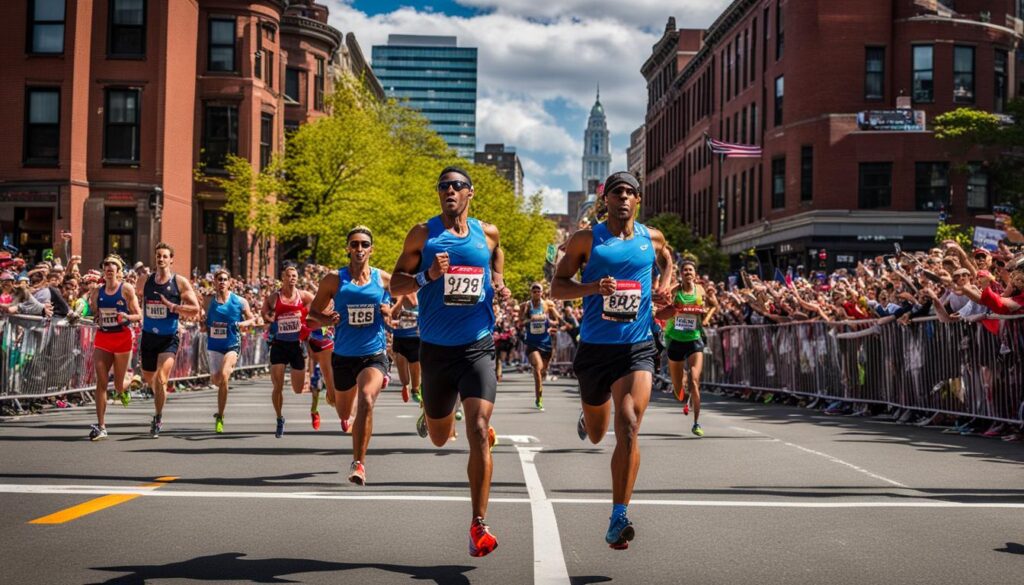
As the oldest annually conducted marathon, the Boston Marathon’s trajectory has mirrored the historical development of running, embodying the transformation of running as a competitive sport into a celebrated global spectacle. This storied footrace not only underscored the growing popularity of marathon running but also championed the ethos of running event inclusivity, a principle that continues to shape international marathons.
The Boston Marathon Legacy
The ardent commitment to long-distance challenges and the escalating magnetism of the Boston Marathon have played a centerpiece role in molding the sport’s international appeal. Marathon running, thanks to the indomitable spirit of the Boston Marathon, has transcended beyond a mere athletic conquest, establishing itself as an emblem of personal triumph and a testament to the enduring allure of endurance running events.
Inclusion of Women in Marathon Running
The transformative sagas of fearless women in running, such as Roberta “Bobbi” Gibb and Kathrine Switzer, marked a watershed moment for both the Boston Marathon and the wider world of competitive marathon running. Fighting against the tide of exclusion, these formidable athletes shattered the boundaries obstructing women from marathon participation and laid the groundwork for subsequent generations, ensuring that running event inclusivity became a hallmark of modern race events. Their tenacity and courage fostered greater recognition for women in running and were pivotal in expanding the umbrella of inclusivity within the realm of competitive sports.
Running as Leisure: The Transformation in the 20th Century
Recreational running emerged in the 20th century as a defining feature of the era’s newfound emphasis on leisure and personal health. The mid-20th century, in particular, witnessed a seismic shift in public perception toward running, which began to be seen as a pastime accessible to everyone rather than an elite competitive sport or a survivalist tactic. This period is marked by the widespread adoption of running for health and enjoyment, paving the way for the running boom in later decades. It was an era when individuals took to the roads and tracks, not for medals or accolades, but for the sheer pleasure and the myriad of health benefits that accompany an active lifestyle.

The 1960s particularly turbocharged the notion of running as pastime, due in part to pioneering figures like Arthur Lydiard, who founded the Auckland Jogger Club. This laid the groundwork for the global running phenomenon and encouraged a community-first approach to the activity. Meanwhile, in the United States, the promotion of running by influential personalities such as Bill Bowerman played an instrumental role. His influence not only permeated the athletic scene but also reached the general public. Bowerman’s work promoted the concept of running for health and helped elevate the everyday act of jogging to become a mainstay in American culture.
The proliferation of running clubs across the globe served as a testament to the activity’s increasing popularity. Running was no longer restricted to the realms of athleticism or military training; it was a democratized activity embraced by all segments of the population. These organizations supported runners of every level, offering a sense of inclusion and community that bolstered the activity’s appeal.
- Arthur Lydiard and the establishment of the Auckland Jogger Club sparked the recreational running trend in New Zealand.
- Bill Bowerman, co-founder of Nike, further popularized jogging in the United States through his books and coaching.
- Running clubs began to flourish, reflecting a significant move away from competition-focused running.
- The diversifying role of running during this period also echoed the broader cultural shifts towards health and wellness.
As we track the narrative of running throughout the 20th century, it is evident that public consciousness about health was dramatically reshaped during this era. The democratization of running is arguably one of the most notable facets of 20th-century well-being and illustrates a pivotal moment in how society approaches exercise and leisure.
Running Reimagined: Technology and Cultural Shifts
In the tapestry of social trends and personal wellbeing, running has undergone a remarkable transformation propelled by the relentless progress of technology and a dynamic cultural landscape. Over recent decades, the influence of running media coverage has not just reported on this evolution but has actively shaped it, placing running at the heart of a cultural phenomenon that intertwines with our daily lives.

The Influence of Media on Running Popularity
The portrayal of running in media significantly impacted its popularity, transitioning from an activity associated with elite athletes to one embraced by the masses for its health benefits and potential for personal expression. Running media’s influence is evident in the widespread adoption of running as a form of leisure, further enriched by stories of perseverance and triumph that resonate with audiences worldwide.
Technological Advancements in Running Gear and Training
As running technology forges ahead, the advancements in running training, and the development of modern running equipment contribute to the sport’s accessibility and popularity. Innovation, particularly in running shoes development, has allowed runners to perform at their best while minimizing the risk of injury.
| Year | Advancement | Impact on Running |
|---|---|---|
| 1960s | Creation of Jogging Clubs | Made running as a recreational activity more prevalent |
| 1970s | Introduction of Custom Running Shoes | Greater comfort and support, leading to increased participation |
| 1980s | Spread of Fitness Trackers | Enabled runners to track progress and set goals |
| 2000s | Advances in Material Technology | Improved running gear with breathable, moisture-wicking fabrics |
| 2010s | Smartphones & Apps | Transformation of running training with a multitude of apps for tracking and motivation |
| 2020s | AI and Machine Learning in Equipment Design | Personalized running gear advancements for performance optimization |
The breakthroughs in both the functional and psychological aspects of running—spanning from the advent of advanced synthetic materials to the customized data analysis powered by artificial intelligence—reflect the intersection of running gear advancements and our daily lives.
With every iterative innovation, running becomes more than just a sport; it’s steadily crafted into a form of personal expression and a testament to human ingenuity. These enhancements have not only changed the way we approach running but have also reaffirmed its status as a significant cultural touchstone.
Social and Health Implications of Running Through the Ages
Delving into the annals of time, it becomes evident that the act of running transcends its origins as survival and sport to extend multifaceted benefits to both health and society. Central to this is the impact of running on cardiovascular health. Regular practitioners of this enduring form of exercise often enjoy a fortified cardiovascular system, reducing the likelihood of heart-related maladies and enhancing overall longevity.
The running health benefits are robust and multifarious, not only enhancing physical endurance but also granting individuals a mental fortitude to face life’s vicissitudes. Regular running is linked to decreased symptoms of depression and anxiety, fostering an improved state of mental wellness. It supports the theory that running and mental health are significantly intertwined, offering a natural remedy for the stresses of modern life.
- Running leads to improved muscle strength
- It enhances lung capacity and efficiency
- Running aids in maintaining a healthy weight
- Regular runners often experience improved sleep quality
Moreover, the social impact of running cannot be overstated. As a communal activity, it has the power to unite diverse groups, forging friendships and support networks along the asphalt and trails. The social implications of running emerge not only from organized events but also from informal running clubs that dovetail the pursuit of health with social enrichment.
The power of running in public health and social settings is immense. As noted by health experts, even small investments in regular running can yield significant dividends across the lifespan.
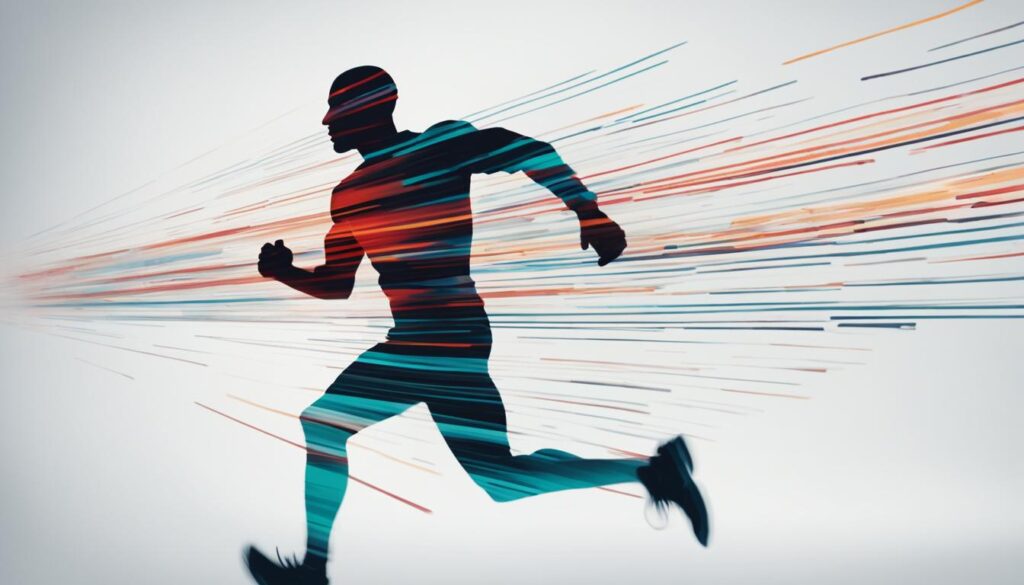
In sum, the narrative of running is marked by its timeless contribution to individual and collective well-being—be it through invigorating the body, soothing the mind, or nurturing societal bonds.
Conclusion
As we reach the end of this fascinating journey through the history of running, we can clearly see the depth and breadth of its impact on society and individual lives. From early human evolution where the timeline of running began, running has stood as a cornerstone in our survival and growth. From ancient survival techniques to the celebrated athletic contests of the Olympic Games, the evolution of running has mirrored that of humanity itself. It is not merely an activity or sport, but a defining character of our species.
Considering the running history timeline, we can appreciate running’s multifunctional nature – serving as a medium for health, competition, social cohesion, and even spiritual expression. It’s an expression that remains vibrant today, from the chalk starting lines of local 5ks to the global spectacles of marathons. Thanks to continuous innovation in technology and a better understanding of the human body, running will no doubt persist in advancing our physical and cultural landscapes. Rather than seeking a definitive point to answer “when was running invented?,” we are reminded that it was never a mere invention but an inherent part of human development.
Today, the story of running continues, indelibly woven into the fabric of global culture, where it maintains its relevance through its simplicity and its deep-seated connections to our beginnings. Its presence across time and societies emphasizes that the invention of running, as a natural and essential part of our existence, is rooted far deeper than any single event or date could pinpoint. Indeed, running stands as a testament to our enduring spirit, our quest for health and joy, and our relentless pursuit of personal and collective excellence.

